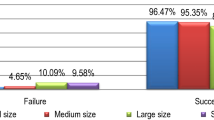Abstract
Myringotomy with the insertion of ventilation tubes is the most frequent surgical procedure performed in children, and the appearance of myringosclerosis is one of its most frequent long-term complications. The objective of this study is to identify clinical factors and technique variations that may have a relation with the appearance of myringosclerosis, after tube insertion. Patients submitted to myringotomy with transtympanic short-term tube insertion were studied in a longitudinal prospective and analytical cohort study with the prospective randomized open, blinded endpoint (PROBE) methodology, to study the influence of the location of myringotomy (anterior–inferior quadrant or posterior–inferior), directions of the incision (radial or non-radial) and aspiration or not of the middle ear. Our study included 156 patients (297 ears). Myringosclerosis was observed in 35.7 % of the operated ears. It appeared more often in patients with greater number of otitis (p = .001) and with greater number of otorrhea episodes (p = .029) and in patients in whom the tympanogram after the tube extraction was type A (according to Jerger´s classification) (p = 0.016). We identified myringosclerosis in less patients, if the tube was in the tympanic membrane for less than 12 months (p = .009). Myringosclerosis was present more extensively if the tympanic incision was located in the anterior–inferior quadrant, with tympanic involvement superior to 25 % (p = .015). The results observed prove that, underlying the appearance of myringosclerosis, there exists an early inflammatory or infectious process and a final cicatricial process. It was also found that when myringotomy is made in the anterior–inferior quadrant, myringosclerosis appears in a higher percentage of the tympanic membrane; therefore, it is not recommended to do the incision in this quadrant, because it may lead to a reduction of the tympanic membrane vibration.
Similar content being viewed by others
References
Gibb AG, Pang YT (1994) Current considerations in the etiology and diagnosis of tympanosclerosis. Eur Arch Otorhinolaryngol 251(8):439–451
Arslan N, Tepe D, Taştan E et al (2012) Evaluation of the effectiveness of topical ciprofloxacin and prednisolone in the prevention of myringosclerosis. Eur Arch Oto Rhino Laryngol 269(11):2335–2341
Yaman H, Guclu E, Yilmaz S, Ozturk O (2010) Myringosclerosis after tympanostomy tube insertion: relation with tube retention time and gender. Auris Nasus Larynx (Internet) 37(6):676–679
Koc A, Uneri C (2001) Sex distribution in children with tympanosclerosis after insertion of a tympanostomy tube. Eur Arch Otorhinolaryngol 258(1):16–19
Tympanosclerosis Chang IW (1969) Electron microscopic study. Acta Otolaryngol (Internet) 68(1):62–72
Wielinga EWJ, Kerr AG (1993) Tympanosclerosis. Clin Otolaryngol 18:341–349
Forséni M, Bagger-Sjöbäck D, Hultcrantz M (2001) A study of inflammatory mediators in the human tympanosclerotic middle ear. Arch Otolaryngol Head Neck Surg 127(5):559–564
Uneri C, Baǧlam T, Yazici M (2006) The effect of vitamin E treatment on the development of myringosclerosis after ventilation tube insertion. Int J Pediatr Otorhinolaryngol 70(6):1045–1048
Leal MC, Bento RF, Neto SD et al (2006) Influence of hypercalcemia in the formation of tympanosclerosis in rats. Otol Neurotol (Internet) 27(1):27–32
Helms J, Steinbach E (1973) Tympanosclerosis. Ind J Otol XXV(1):25–27
Khodaverdi M, Jørgensen G, Lange T et al (2013) Hearing 25 years after surgical treatment of otitis media with effusion in early childhood. Int J Pediatr Otorhinolaryngol (Internet) 77(2):241–247
Kinis V, Ozbay M, Alabalik U et al (2015) Effect of caffeic acid phenethyl ester on myringosclerosis development in the tympanic membrane of rat. Eur Arch Oto Rhino Laryngol (Internet) 272(1):29–34
de Carvalho Leal M, Ferreira Bento R, da Silva Caldas Neto S et al (2006) Influence of hypercalcemia in the formation of tympanosclerosis in rats. Otol Neurotol 27(1):27–32
Friedman EM, Sprecher RC, Simon S, Dunn JK (2001) Quantitation and prevalence of tympanosclerosis in a pediatric otolaryngology clinic. Int J Pediatr Otorhinolaryngol 60(3):205–211
Özcan C, Görür K, Cinel L, Talas DU, Ünal M, Cinel I (2002) The inhibitory effect of topical N-acetylcysteine application on myringosclerosis in perforated rat tympanic membrane. Int J Pediatr Otorhinolaryngol 63(3):179–184
Parker A, Maw A, Powell J (1990) Intra-tympanic membrane bleeding after grommet insertion and tympanosclerosis. Clin Otolaryngol Allied Sci 15(3):203–207
Kaur K, Sonkhya N, Bapna AS (2006) Tympanosclerosis revisited. Indian J Otolaryngol Head Neck Surg 58(2):128–132
Barati B, Hashemi SM, Tabrizi AG (2012) Otological findings 10 years after myringotomy with tympanostomy tube insertion. Iran J Otorhinolaryngol 24(4):181–186
De Beer BA, Schilder AGM, Zielhuis GA, Graamans K (2005) Natural course of tympanic membrane pathology related to otitis media and ventilation tubes between ages 8 and 18 years. Otol Neurotol 26(5):1016–1021
Tos M, Bonding P, Poulsen G (1983) Tympanosclerosis of the drum in secretory otitis after insertion of grommets. A prospective, comparative study. J Laryngol Otol 97(6):489–496
Schiff M, Yoo TJ (1985) Immunologic aspects of otologic disease: an overview. Laryngoscope 95(3):259–269
Forséni Flodin M, Hultcrantz M (2002) Possible inflammatory mediators in tympanosclerosis development. Int J Pediatr Otorhinolaryngol 63(2):149–154
Sprem N, Branica S, Dawidowsky K (2002) Experimental hematotympanum–aspects to the tympanosclerosis development. Coll Antropol 26(1):267–272
Laina V, Pothier DD (2006) Should we aspirate middle-ear effusions prior to insertion of ventilation tubes? J Laryngol Otol 120(10):818–821
Paço J (2003) Estrutura do Tímpano. In: Paço J (ed) Doenças do Tímpano. Lisbon, PT: Lidel—edições técnicas, Lda, pp 55–72
Maw AR (1991) Development of tympanosclerosis in children with otitis media with effusion and ventilation tubes. J Laryngol Otol 105:614–617
Author information
Authors and Affiliations
Corresponding author
Ethics declarations
Conflict of interest
The authors declare that they have no conflict of interest.
Rights and permissions
About this article
Cite this article
Branco, C., Monteiro, D. & Paço, J. Predictive factors for the appearance of myringosclerosis after myringotomy with ventilation tube placement: randomized study. Eur Arch Otorhinolaryngol 274, 79–84 (2017). https://doi.org/10.1007/s00405-016-4194-z
Received:
Accepted:
Published:
Issue Date:
DOI: https://doi.org/10.1007/s00405-016-4194-z




